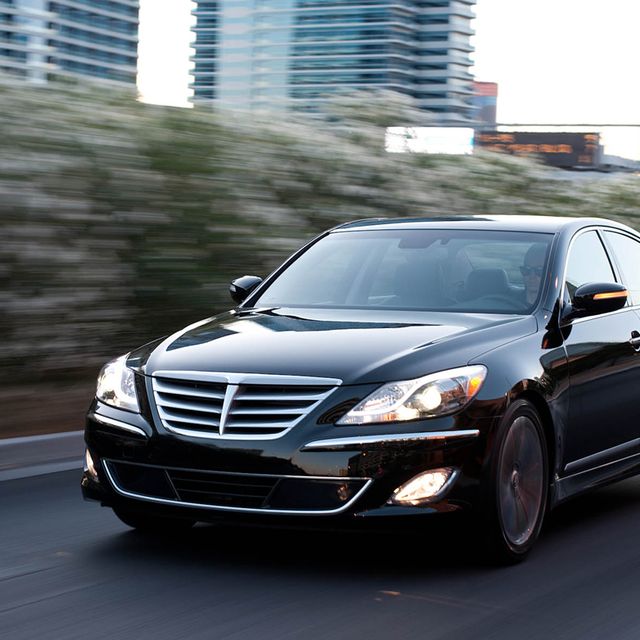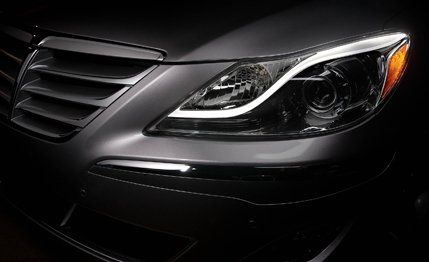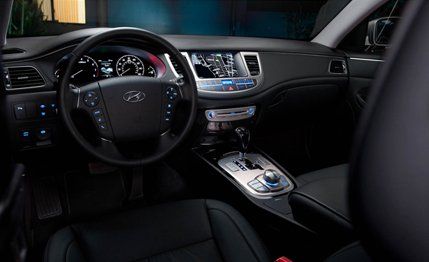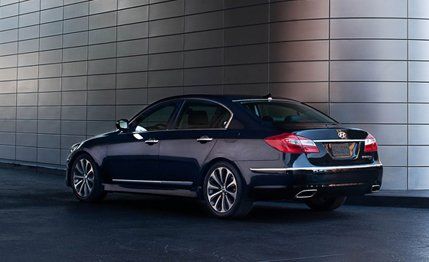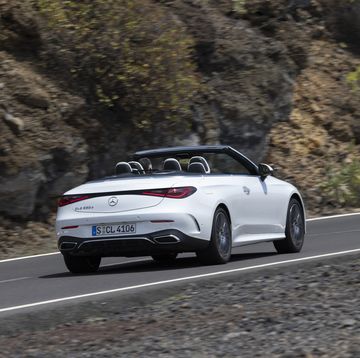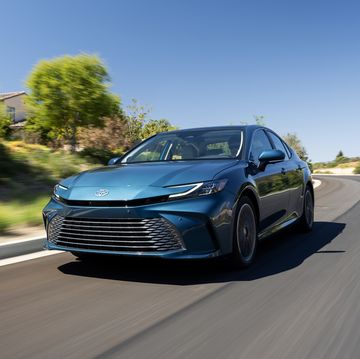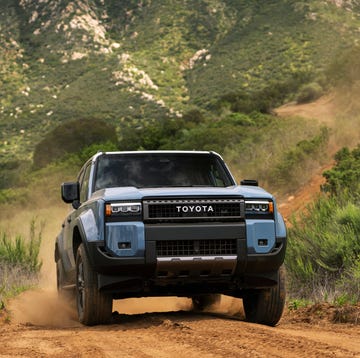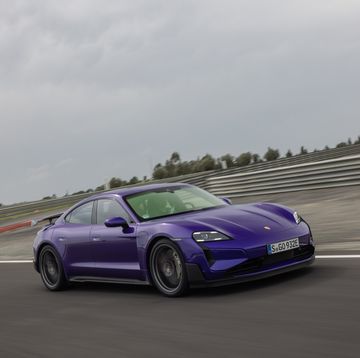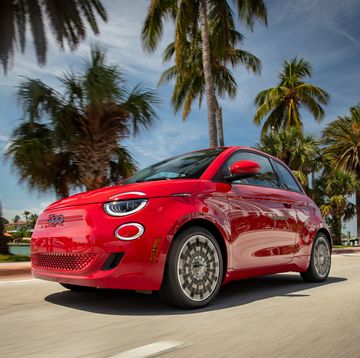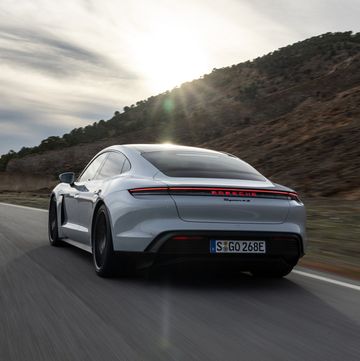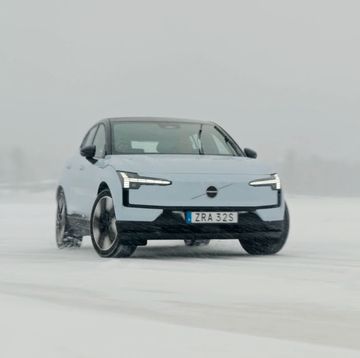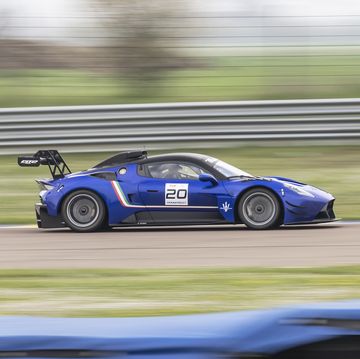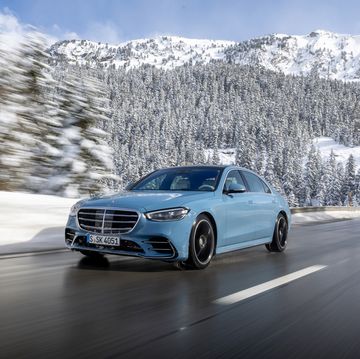Hyundai has repeatedly said it would not—cannot—put a V-8 in the Genesis coupe, but the 2012 Genesis sedan presents the best reason yet for the company to do so (even if it had to put it in the trunk, like Rhys Millen already did). With Hyundai’s new 5.0-liter V-8 between its fenders, the coupe would be a liter-for-liter Korean response to the Ford Mustang GT 5.0, and the Vanilla Ice references could turn into Vanilla Rice jokes. Hyundai has yet to express interest in this sort of enablement.
The 429-hp 5.0—only available in the Equus and new Genesis R-Spec—headlines a suite of changes Hyundai is making to the cheaper of its luxury sedans for 2012. The 3.8-liter V-6 in the base Genesis gets direct injection, which boosts its output from 290 hp to 333, and a new eight-speed automatic transmission—developed by Hyundai itself—is fitted to all Genesis sedans. Additionally, Hyundai has made small tweaks to the suspension of all cars and fitted all with a new grille and fascias, new headlights with LED accents and daytime-running lights, redesigned rocker panels, and new taillights.
Stay Focused
Although the 5.0 is the sexiest item on the upgrade list, the most important is the tweaked suspension. As it was introduced, the Genesis paired a flinty ride with floppy, blasé handling. The balance is vastly improved for 2012, with the ride smoothing out and the car staying a bit flatter in hard cornering, thanks in part to a 1-mm-larger rear anti-roll bar (18 vs. 17). Additionally, last year’s car’s propensity to slam over big divots and lumps and bottom out as though it used Slinkys as springs is gone, with far fewer imperfections making their way into the cabin.
The 15-percent power increase in the 3.8 (333 hp) moves it closer to the 385-hp, 4.6-liter V-8, which now surpasses the six’s output by 52 ponies—43 fewer than last year’s. The base motor yanks the car forward with even more vigor and does so with a seasoned smoothness. The 5.0 will replace the 4.6-liter as the base engine in the Equus for 2012, and we wouldn’t be surprised to see the 4.6 fade from the options list of the Genesis as well. The 5.0-liter is really a 4.6 with a larger bore—96 mm versus 92—so Hyundai isn’t throwing away a bunch of R&D dollars by discontinuing the smaller engine.
Bewinged-Japanese-Coupe Badge on a Korean Luxury Sedan
But you want to read about the R-Spec, we know. As mentioned above, the 5.0 and the 4.6 are closely related. Compared with its smaller ancestor, the R-Spec V-8 adds direct fuel injection, which enables a higher compression ratio of 11.5:1 instead of the 4.6’s 10.4:1. That’s it. Otherwise, it’s the same engine, carrying over the 4.6’s variable timing for both intake and exhaust cams. Mileage is only slightly affected, with the 5.0 earning 16 mpg city and 25 highway ratings from the EPA, 1 mpg down on the 4.6 in both categories.
The 5.0 is a bit peaky, needing 6400 rpm and premium gas to produce all 429 hp and 5000 rpm to hit its max torque of 376 lb-ft . At part throttle and right off the line, it doesn’t feel much spunkier than the 4.6. But at higher speeds—both road and engine—the car pulls like Germany’s best executive Q-ships. Hyundai expects 0 to 60 mph to take 5.1 seconds; we predict a 4.8-second sprint. Although the working-class associations of “5.0” had us hoping for a bit more Woodward growl from the tailpipes, this engine’s muffled voice falls short of even its Teutonic targets’.
Aside from the bigger V-8, the R-Spec differentiates itself from lesser Genesis models with various suspension and brake tweaks. A further 1-mm bump in rear-anti-roll-bar diameter supposedly cinches it down a bit more, but we didn’t get a chance to toss the car into any aggressive hairpins to verify this. What we were able to discern is that the moderately higher spring rates somewhat negate the other 2012 Genesis’s breakthroughs in the ride-and-handling arena, rediscovering some of the flintiness that other models thankfully left behind. Larger wheels—19 inches on the R-Spec—might also be partly to blame. We’d probably be happier with just the motor. Well, and the larger brakes. Six-cylinder cars upgrade to the 13.0-inch front rotors from last year’s 4.6 model; both V-8 cars now wear 13.6-inch front discs. Finally, the Genesis doesn’t get the same exuberant color palette as does Hyundai’s other big 2012 intro, the Accent, so we’d like to see the R-Spec offered in hues other than black, less black, and gray (Black Noir Pearl, Titanium Gray Metallic, Platinum Metallic).
Eight Can Be Great
Regardless of engine, every 2012 Genesis will have an eight-speed automatic. As opposed to many other automakers that use transmissions from outside suppliers, Hyundai chose to design its own slushbox. Maybe it shouldn’t have. Eight speeds allow for a fine balance of economy and zest, but the transmission is slow. Up- and downshifts drag, and we were able to count off full seconds before getting what we wanted after stomping through the kickdown switch. All cars have a gate for manual actuation, but when the transmission takes longer to respond than an estranged fourth wife, it’s hard to care. On the other hand, those who buy a Genesis for its highway serenity—so all of them, including R-Spec buyers—might not notice, and they’ll appreciate the slight fuel-economy benefit. Cars with the V-6 are rated at 19 mpg city and 29 highway (up from 18/27 last year); those with the 4.6 are 17/26 (up from 17/25); and the R-Spec is 16/25.
With all the new stuff, the base 2012 Genesis sees a $1200 increase in starting price from last year’s $33,850 to $35,050. Considering the improved ride and increased power, that’s reasonable. And as before, there’s a tremendous list of standard equipment: leather seats, keyless entry and start, heated power front seats, a seven-speaker stereo with satellite radio and USB and 3.5-mm auxiliary input jacks, and a spacious rear seat. The 4.6 pops the sticker up to $45,350 (an increase of $1500 over last year’s) and includes $8800 worth of packages that are optional on the 3.8—notably, a sunroof, a power tilting-and-telescoping steering wheel, a rear sunshade, a 17-speaker Lexicon stereo, navigation, a rearview camera, adaptive cruise control, a (refreshingly inoffensive) lane-departure-warning system, a cooled driver’s seat, and heated rear seats. For another two grand, buyers can find their way into an R-Spec. They’d better really want the power, because visual cues of the R-Spec’s specialness are few: unique headlamps with dark-chrome inserts, 19-inch wheels, a trunklid badge, and floor mats.
As we found when we pitted the Genesis against its competition, the cars that should fear it the most aren’t German thoroughbreds but are instead traditional mid-premium cars, which it thoroughly routs. Like before, there’s much about the Genesis to suggest it is far more expensive than it is. Now, though, Hyundai’s full-size luxury car doesn’t look rich just on paper: It feels more like it from behind the wheel, too.
Specifications

Jared Gall started his career with Car and Driver as an unpaid intern, but has now worked here more than half of his life. He has held numerous positions within C/D's digital and print teams and has driven some 2500 cars. Employee records indicate that he is the only staffer ever to T-bone a school bus with another school bus.
